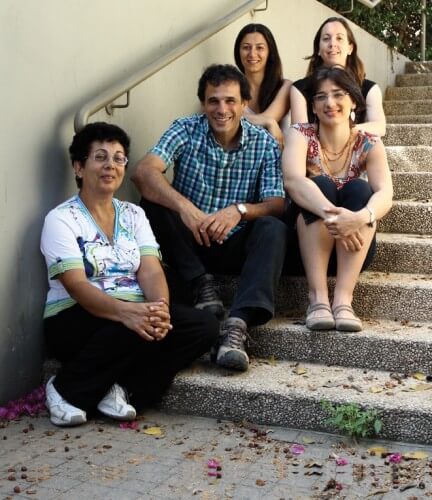In a study recently published in the scientific journal Nature Cell Biology, Prof. Gross and his team members asked to get a more complete picture of BID activity

Our behavior depends not only on who we are, but also on where we are and in whose company. This is also true for the behavior of the protein called BID, which plays a central role in the life cycles of the cells in our body. Scientists at the Weizmann Institute of Science discovered that this protein is able to divide its activity between two different sites in the cell, and that its activity in each of them may be a matter of life or death. These findings may make an important contribution to the understanding of many diseases, starting with a rare genetic disease, and ending with common metabolic syndromes such as obesity and diabetes.
When Prof. Eitan Gross, from the Department of Biological Control, and the members of his research team began to examine the BID protein in vitro, they discovered that it is the one that chooses where to direct damaged cells - such as, for example, cells whose genetic material is damaged: will they kill themselves to save the entire creature , or they will undergo correction and continue to live. It was also discovered that a second protein called ATM is involved in this role - a kind of "manager" that oversees the actions of BID and a number of other proteins. The research team discovered that as long as ATM maintains contact with BID, the damaged cell remains alive. When ATM avoids this connection, BID binds to proteins found on the surface of organelles called mitochondria - the cell's energy suppliers - and then begins the chain of events that leads to cell death.
In a study recently published in the scientific journal Nature Cell Biology, Prof. Gross and his team members sought to obtain a more complete picture of BID activity. To this end, together with the research students Maria Marianovitch and Galia Overkovitz and Dr. Hagit Niv, they created mice with a mutation in the BID protein, which prevents it from receiving instructions from ATM.
The experiments, led by Maria Marjanovic, showed that BID is able to perform several functions at the same time. As they discovered in vitro experiments, it is responsible for the cell's decision whether to commit suicide or stay alive. The scientists were not surprised to find that BID-mutated cells tended to commit suicide at high rates, especially bone marrow cells, which are particularly sensitive to DNA damage. Additionally, and seemingly unrelated, BID also controls the development of bone marrow stem cells into mature, functioning blood cells. These stem cells serve as reserves for all types of blood cells throughout the life of the creature, and their differentiation is a strictly controlled process. In contrast, in mice that underwent the mutation that prevented BID from communicating with ATM, the stem cells differentiated continuously, and their pool in the bone marrow was rapidly depleted.
To understand how BID plays two different roles at the same time, the scientists looked at where it goes and which proteins it meets. They found that the meetings with ATM take place in the cell nucleus. Their experiments showed that ATM carries a physical "exclusion order", which tells BID to stay in its place - away from the mitochondria. Without this command from ATM, the BID moves freely to its alternative site, on the surface of the mitochondria. There begins a sequence of events: its meeting with mitochondrial proteins causes the creation of active oxygen compounds. These compounds act like rifle bullets, which tear holes in the mitochondrial membrane, thus allowing the release of toxins that kill the entire cell. The same compounds also serve as a kind of "emergency signal" to the stem cells in the bone marrow, which calls them to quickly differentiate into blood cells.
The scientists believe that the partnership between BID and ATM acts as a control mechanism, which senses the amount of damage caused to DNA in the cell, and adjusts the levels of active oxygen compounds accordingly. According to Prof. Gross, these findings are surprising - not only because of the newly discovered role of BID. They also yielded interesting insights into a hitherto unknown relationship between mitochondria and the cell nucleus, and revealed the close relationship between two stages in the cell's life cycle - cell suicide, and regeneration of mature cells.
Prof. Gross and his team members believe that these findings may be relevant in the future for biomedical research. Mutations in ATM in humans cause a rare but very severe disease - Ataxia-Telangectesia - which affects all parts of the body. It seems that most of the severe symptoms of the disease are related to an excess of active oxygen compounds, which cause damage. Prof. Gross believes that developing ways to delay BID may alleviate these symptoms, and prolong the lives of patients. In addition, wider applications may be found: various studies have recently hinted at a link between BID behavior, and other proteins to which it binds, and metabolic syndromes such as obesity and diabetes, as well as autoimmune diseases and even cancer. Therefore, there can be many good reasons to find ways to direct BID to the right place, and to the right meetings, at the right time.
Also participating in the research were: Dr. Judith Salzman and Lydia Verbiov from the Department of Biological Control, Prof. Stefan Jung and Prof. Zvi Lapidot from the Department of Immunology, and Dr. Rivka Hefner and Dr. Uri Brenner from the Department of Veterinary Resources.
One protein - two faces. Illustration: Alit Avni-Sharon
